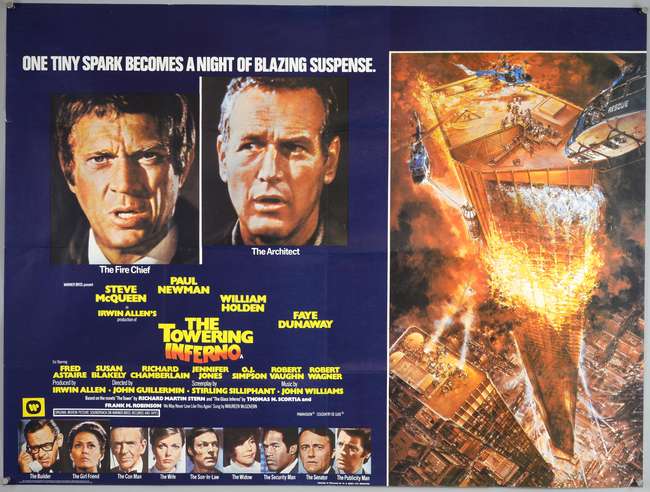I’ve been having an unusually elevated number of conversations of late about crises and how you manage them from a PR/communications standpoint. I devoted an entire chapter in my book, BITE THE DOG: Build a PR Strategy to Make News That Matters, to stories and tips on emerging from a crisis with not just minimal damage, but even maximum opportunity. I called the chapter what I’ve titled this blog. I hope the excerpt below offers some helpful insight:
————————
I referred back in Chapter 6 to a media firestorm being “like something out of an Irwin Allen movie.” That allusion may have gone over the heads of some readers, like a few others I’ve sprinkled throughout because I just can’t help myself as a child enslaved to ’70s and ’80s pop culture. For those who don’t know, Allen was a film producer nicknamed the “Master of Disaster” for ushering in Hollywood’s 1970s fascination with the disaster movie, a genre that visited a natural (Earthquake, The Poseidon Adventure) or man-made (The Towering Inferno, the four Airport sagas) calamity upon an all-star cast of the era’s biggest stars. A good deal of the fun of such pictures, aside from the grand scale and state-of-the-art-at-the-time special effects, was trying to guess which A-list Oscar winner slumming it for a hefty payday would survive the torrents of peril till the credits rolled.
PR crises can feel a lot like you’re Paul Newman or Charlton Heston, Faye Dunaway or Ava Gardner, inside your very own disaster movie. They tend to appear and upset your life’s apple cart without warning, sometimes set in motion by external forces, sometimes internal ones. They are rife with moments that make your heart race, situations where if you make the right decision you’re safe and the wrong one you’re doomed, and times you’re hit with the very real (figurative) feeling that you won’t get out alive. Just as every disaster film features a leader who rises from the ranks of initial survivors to lead those who hang on to ultimate safety, your chances of emerging from the rubble, ashes or water of your crisis rise exponentially if you have a public-relations professional as your guide.
Each crisis is different, of course, but most require two levels of engagement:
• Identification and assessment. This is where you find out what’s wrong and how bad it is. It’s your information-gathering stage, and time is a precious commodity, measured in minutes and hours, not days and weeks. As many hands as you can call to the deck need to be brought together to determine what happened and how it happened. You need to know who’s affected; is this only a problem for your brand/organization’s reputation, or has genuine harm been caused to your consumers and clients and/or the public? You need to get a grasp on whether the incident responsible for the crisis is internal: Did you or someone associated with you misspeak or misbehave, committing the kind of news you don’t want to commit? Or have external factors like product malfunction or cavalcades of criticism dented the goodwill you’ve worked so hard to build in the marketplace of ideas?
This is also the stage at which you need to decide if you’re going to do anything about it. Read that last sentence carefully. This isn’t the time you decide what you’re going to do to confront and clear up the crisis. It’s when you decide if you’re going to do anything proactive to confront and clear up the crisis. Remember what I said about the 24-hour news cycle breeding short memories? You may decide the best strategy is to offer no response, to let tomorrow’s headlines wipe away today’s. Doing so, doing nothing, is always a calculated risk. Depending on the severity of the crisis, and the tentacles that could grow from it like a Hydra’s heads and extend or deepen the crisis with more unfavorable news stories, silence may be the golden decision. If it’s not, though, you need to stop thinking and start doing.
• Response, not reaction. If you decide to speak up and out in an effort to mitigate the crisis, to douse it down to its embers so it has no chance of conflagrating again, you’re going to need a strategy. Everything we’ve talked about to this point about effective PR being the—scream it like you’re an extra in a disaster movie!—wise leveraging of expectations and opportunities applies to crisis communications, too. Even more so.
The worst thing you can do is rush out a comment that’s only been half thought-through. That’s a reaction; you need a response. It must address the source of the crisis, acknowledge your or your allies’ role in it and propose what you’ll do to drop the situation back down below DEFCON 3. By now the initial hours of the crisis will have unfurled, but you’re still working in terms of hours and days. Implementing and carrying out your response—if it involves a recall or cleanup from a man-made disaster like an oil spill, for instance—is when you start getting into weeks and months territory. Those situations are unlikely to crop up for you as an author, expert, speaker, coach and consultant.



Recent Comments